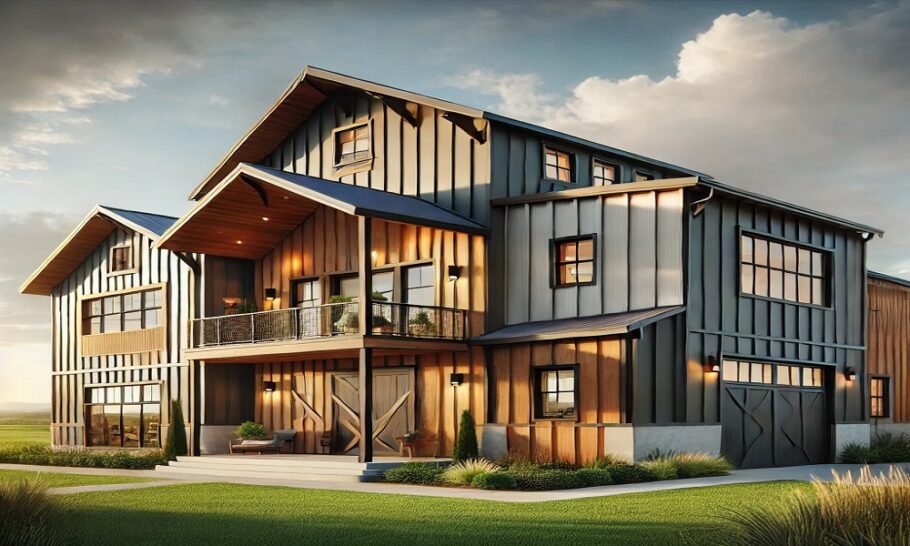Barndominiums have earned their reputation as one of the most flexible home styles in modern residential design. With their vast interior volumes, metal framing systems, and open-plan possibilities, they provide an architectural playground for creativity. But in the sea of single-story or full two-story barn homes, a newer trend is emerging: the split-level barndominium.
This design strategy introduces half-levels within the barndominium structure—creating visual variety, better spatial separation, and dynamic interaction between living areas. It’s a clever middle ground between a sprawling one-story and a tall two-story design, blending practicality with architectural intrigue.
Let’s explore how the split-level concept translates into barndominium architecture, the engineering and design strategies that make it possible, and why it may be the perfect solution for homeowners seeking a fresh take on modern rural living.
What Is a Split-Level Barndominium?
Traditionally, a split-level home has staggered floor levels—typically, one main floor (living, dining, and kitchen), a half-flight of stairs up to the bedrooms, and a half-flight down to a family or utility area. The idea originated in mid-century suburban homes, where it efficiently accommodated sloped lots and gave visual definition to open interior layouts.
In a barndominium, the split-level approach adapts beautifully. Since barndominiums often feature large, open-span interiors, introducing half-levels breaks up the expanse while maintaining the sense of openness. For instance:
- The main living space may sit at ground level.
- A raised half-level might house bedrooms or an office loft.
- A lower half-level could include a workshop, garage, or entertainment space.
These subtle vertical shifts redefine the way occupants move through and experience the space—adding drama, intimacy, and functional separation without the need for full walls or floor divisions.
Why Choose a Split-Level Barndominium?
A split-level layout can be both aesthetic and functional. Homeowners and designers are drawn to it for several key reasons:
- Maximizing Space Without Expanding Footprint
On rural lots, space might be abundant—but construction costs and site grading can limit how much of it you use. Split-level design cleverly stacks usable square footage vertically. Instead of expanding outward, you gain livable zones by working with vertical offset levels.
This is particularly beneficial for smaller or sloped parcels, where a standard single-level barndominium might require excessive excavation or grading.
- Design Flexibility and Visual Interest
Barndominiums are often criticized for their “big box” look—especially when built as single-story rectangles. A split-level design instantly disrupts that monotony. The slight change in elevation can influence both the exterior silhouette and interior sightlines, giving the structure a multi-dimensional feel.
From the outside, you can express the level change through shifts in roofline, material transitions, or clerestory windows. Inside, split levels help define spaces while maintaining visual connection.
- Functional Zoning
In open-concept barndominiums, sound and activity often flow freely between rooms. Half-levels introduce natural zoning. For example:
- The main floor remains social—kitchen, dining, and living.
- A few steps up, the bedrooms enjoy privacy.
- A few steps down, the workshop or family room operates semi-independently.
This subtle separation enhances day-to-day living comfort without compromising openness.
- Adaptability to Sloped Sites
If your property sits on uneven terrain, the split-level approach can save thousands in grading costs. Instead of forcing a perfectly level foundation, you can work with the slope, stepping the structure to follow the natural contour of the land. This minimizes excavation, improves drainage, and makes the building feel more organically tied to its site.
- Energy and Environmental Advantages
Smaller, segmented zones can make heating and cooling more efficient. For example, the lower level might stay cooler naturally, while upper zones receive more light and warmth. This division allows targeted HVAC zoning, reducing overall energy use.
Architectural Strategies for Split-Level Barndominiums
Successfully integrating split levels into a barndominium design requires more than just adding stairs—it’s a matter of thoughtful spatial planning and structural engineering.
Here are the key design strategies:
- Play with the Barndominium Volume
Metal post-frame or steel-frame structures usually favor wide, open bays. To create half-levels, designers can:
- Introduce partial mezzanines supported by secondary beams.
- Step the foundation slab at designated zones.
- Use loft floors that align mid-way between main levels.
The trick is balancing vertical change while maintaining headroom and sightlines across spaces.
- Express the Levels in the Exterior
Split levels naturally lend themselves to exterior expression. Consider:
- A tiered roofline, where each half-level defines its own volume.
- A walk-out lower level, ideal for sloping lots.
- Varied siding or color palettes to highlight each section.
This gives your barndominium a dynamic, layered look—far removed from the flat industrial box aesthetic.
- Align Function with Elevation
Each half-level should serve a clear purpose:
- Lower levels: garage, mechanical rooms, workshop, mudroom, or entertainment area.
- Main (mid) level: kitchen, dining, and main living zone.
- Upper half-levels: bedrooms, office, or loft library.
This functional stacking aligns circulation patterns with everyday use and helps with sound isolation between zones.
- Integrate Stair Design as a Focal Point
Because split levels rely on short runs of stairs, the stairwell becomes a major design element. Floating stairs, metal-and-wood hybrids, or glass railings can visually connect the spaces. A centrally located stairway can also act as an organizing spine through the house.
- Mind the Engineering
A split-level barndominium requires careful attention to structural and mechanical coordination:
- Foundation stepping demands precise elevation control.
- Load transfer through mid-level beams and joists must be engineered to maintain stability.
- Plumbing and HVAC routes must accommodate level changes without compromising ceiling height or accessibility.
Partnering with a professional engineer experienced in barndominium framing systems is crucial here—especially when mixing steel structures with stepped slabs or wood framing transitions.
Design Inspiration: Split-Level Barndominium Concepts
Let’s look at a few ways to apply this concept creatively:
- The Hillside Retreat
A barndominium built into a hillside can use the slope to its advantage:
- The upper half-level serves as the entry, leading into a vaulted great room.
- Half a flight down, a walk-out basement opens to the landscape.
- Clerestory windows bring daylight deep into the lower level.
This design connects both floors visually while integrating beautifully into the terrain.
- The Family Hub
For families, the split-level plan naturally separates noisy and quiet areas:
- A mid-level open kitchen/living space encourages togetherness.
- Steps up lead to bedrooms and private zones.
- Steps down connect to a game room or media space.
Each section feels distinct yet cohesive.
- The Work-and-Live Barn
If you run a small business or workshop from home, a split-level layout helps delineate work-life boundaries:
- Lower level: office, shop, or studio with direct outside access.
- Mid-level: residential living areas.
- Upper half-level: private sleeping loft or guest suite.
You get the practicality of separation without sacrificing proximity.
Accessibility and Future-Proofing Considerations
Split-level homes, while stylish, can pose accessibility challenges—particularly for aging homeowners or those with mobility limitations. However, with thoughtful design, these issues can be mitigated.
- Install shallow riser stairs (6” or less) to ease movement between levels.
- Design for stairlift or platform lift integration in one of the short runs.
- Locate essential functions (bedroom, bath, laundry) on the main level for single-level living flexibility.
By planning ahead, you can enjoy the architectural benefits of a split-level while keeping it adaptable for all life stages.
The Cost Perspective
A split-level barndominium generally costs slightly more than a single-level equivalent but less than a full two-story structure. The primary cost drivers are:
- Additional foundation work (stepped slabs).
- Structural modifications for mid-level support.
- Finishes and stair fabrication.
However, the return on investment can be significant. Split-levels often increase resale appeal, offering a unique layout that stands out among traditional barndominiums.
Bringing It All Together
The split-level barndominium captures the best of both worlds: the openness of modern barn-style living and the spatial layering of multi-level architecture. It’s ideal for homeowners who want more architectural character, better space separation, and a design that flows naturally with the land.
Whether you’re designing on a sloped site, need to separate workshop and living zones, or simply crave a more visually dynamic floor plan, the split-level concept offers endless potential.
At Alldraft Design Services, we’ve seen growing demand for these innovative layouts among clients seeking distinctive, livable, and efficient designs. With expert engineering and creative planning, a split-level barndominium can transform a simple metal shell into an architectural statement—one half-level at a time.

